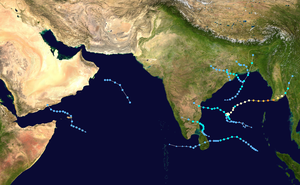
Back Zyklonsaison im Nordindik 2008 German Saison cyclonique 2008 dans l'océan Indien nord French Temporada de ciclones no Índico Norte de 2008 Portuguese 2008年北印度洋氣旋季 Chinese
| 2008 North Indian Ocean cyclone season | |
|---|---|
 Season summary map | |
| Seasonal boundaries | |
| First system formed | April 27, 2008 |
| Last system dissipated | December 8, 2008 |
| Strongest storm | |
| Name | Nargis |
| • Maximum winds | 165 km/h (105 mph) (3-minute sustained) |
| • Lowest pressure | 962 hPa (mbar) |
| Seasonal statistics | |
| Depressions | 10 |
| Deep depressions | 7 |
| Cyclonic storms | 4 |
| Severe cyclonic storms | 1 |
| Very severe cyclonic storms | 1 |
| Extremely severe cyclonic storms | 1 |
| Super cyclonic storms | 0 |
| Total fatalities | 138,927 total (Fifth-deadliest tropical cyclone season on record overall) |
| Total damage | ~ $15.4 billion (2008 USD) (Second-costliest North Indian Ocean cyclone season on record) |
| Related articles | |
The 2008 North Indian cyclone season was one of the most disastrous tropical cyclone seasons in modern history, causing more than 140,000 fatalities and over US$15 billion in damage. At the time, it was the costliest season in the North Indian Ocean, until it was surpassed by 2020. The season has no official bounds but cyclones tend to form between April and December. These dates conventionally delimit the period of each year when most tropical cyclones form in the northern Indian Ocean. There are two main seas in the North Indian Ocean—the Bay of Bengal, which is east of India, and the Arabian Sea, which is west of India. The official Regional Specialized Meteorological Centre in this basin is the India Meteorological Department (IMD), however the Joint Typhoon Warning Center releases unofficial advisories for military interests. An average of four to six storms form in the North Indian Ocean every season.[1] Cyclones occurring between the meridians 45°E and 100°E are included in the season by the IMD.[2]
During 2008, the IMD monitored a total of ten depressions across the North Indian Ocean, significantly below the average of fifteen. Of these systems, seven developed into deep depressions, four into cyclonic storms, and one into a very severe cyclonic storm.[3] The JTWC unofficially tracked seven systems, with six having one-minute sustained winds greater than 65 km/h (40 mph), slightly above their 32-year average of five.[4] Activity was mainly confined to the Bay of Bengal, with only two depressions developing in the Arabian Sea. Collectively, there were a total of 30 days of activity in the basin, with no storms existing simultaneously.[3]
The first and most destructive storm of the season, Cyclone Nargis struck the Irrawaddy Delta in southern Myanmar, with a 3 to 5 m (9.8 to 16.4 ft) storm surge. Approximately 800,000 homes were severely damaged or destroyed and infrastructure was devastated. An estimated 138,373 people lost their lives and damage reached K13 trillion (US$15.6 billion). Nargis is regarded as the worst disaster in the nation's history as well as the fourth-deadliest tropical cyclone on record. Other storms throughout the season caused significant damage in Bangladesh, India, Sri Lanka, and Yemen. A depression in October was responsible for 180 deaths and US$1.638 billion in damage across Yemen. Overall, approximately 138,927 people were killed and losses totaled $15.4 billion (2008 USD).
- ^ "IMD Cyclone Warning Services: Tropical Cyclones". India Meteorological Department. Archived from the original on November 4, 2008. Retrieved May 19, 2013.
- ^ "Report on Cyclonic Disturbances Over the North Indian During 2008". India Meteorological Department. January 2009. Archived from the original (PDF) on May 29, 2009. Retrieved May 19, 2013.
- ^ a b "Report on Cyclonic Disturbances Over North Indian Ocean During 2008: Cyclonic Activities Over the North Indian Ocean During 2008" (PDF). India Meteorological Department. 2009. pp. 16–23. Archived from the original (PDF) on April 12, 2013. Retrieved May 19, 2013.
- ^ "Annual Tropical Cyclone Report: North Indian Ocean Tropical Cyclones" (PDF). Joint Typhoon Warning Center. United States Navy. 2009. pp. 46–48. Archived from the original (PDF) on February 21, 2013. Retrieved May 19, 2013.
© MMXXIII Rich X Search. We shall prevail. All rights reserved. Rich X Search